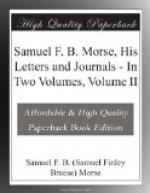“Mr. Kendall is too well known in American history to require description. He was General Jackson’s Postmaster General, incorruptible, able, an educated lawyer, clear-headed, methodical, and ingenious. But he was somewhat rigid in his manners and methods, and lacked the dash and bonhomie which would have carried him successfully into the business centres of the seaboard cities, and brought capital largely and cheerfully to his feet. Of personal magnetism, indeed, except in private intercourse, where he was eminently delightful, he had, at this period of his life, none. This made his work difficult, especially with railroad men. Yet the Telegraph could not have been entrusted to more genuinely honest and able hands. On the part of those he represented this confidence was so complete that their interests were committed to him without reserve.”
Professor Gale and Alfred Vail joined with Morse in entrusting their interests to Mr. Kendall’s care, but F.O.J. Smith preferred to act for himself. This caused much trouble in the future, for it was a foregone conclusion that the honest, upright Kendall and the shifty Smith were bound to come into conflict with each other. The latter, as one of the original patentees, had to be consulted in every sale of patent rights, and Kendall soon found it almost impossible to deal with him.
At first Kendall had great difficulty in inducing capitalists to subscribe to what was still looked upon as a very risky venture. Mr. Corcoran, of Washington, was the first man wise in his generation, and others then followed his lead, so that a cash capital of $15,000 was raised. Mr. Reid says: “It was provided, in this original subscription, that the payment of $50 should entitle the subscriber to two shares of $50 each. A payment of $15,000, therefore, required an issue of $30,000 stock. To the patentees were issued an additional $30,000 stock, or half of the capital, as the consideration of the patent. The capital was thus $60,000 for the first link. W.W. Corcoran and B.B. French were made trustees to hold the patent rights and property until organization was effected. Meanwhile an act of incorporation was granted by the legislature of the State of Maryland, the first telegraphic charter issued in the United States.”
The company was called “The Magnetic Telegraph Company,” and was the first telegraph company in the United States.
Under the able, if conservative, management of Mr. Kendall the business of the telegraph progressed slowly but surely. Many difficulties were encountered, many obstacles had to be overcome, and the efforts of unprincipled men to pirate the invention, or to infringe on the patent, were the cause of numerous lawsuits. But it is not my purpose to write a history of the telegraph. Mr. Reid has accomplished this task much better than I possibly could, and, in following the personal history of Morse, the now famous inventor, I shall but touch, incidentally on all these matters.




